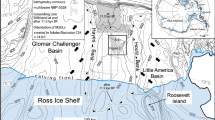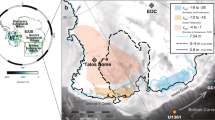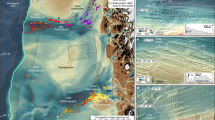Abstract
Climate variations cause ice sheets to retreat and advance, raising or lowering sea level by metres to decametres. The basic relationship is unambiguous, but the timing, magnitude and sources of sea-level change remain unclear; in particular, the contribution of the East Antarctic Ice Sheet (EAIS) is ill defined, restricting our appreciation of potential future change. Several lines of evidence suggest possible collapse of the Totten Glacier into interior basins during past warm periods, most notably the Pliocene epoch1,2,3,4, causing several metres of sea-level rise. However, the structure and long-term evolution of the ice sheet in this region have been understood insufficiently to constrain past ice-sheet extents. Here we show that deep ice-sheet erosion—enough to expose basement rocks—has occurred in two regions: the head of the Totten Glacier, within 150 kilometres of today’s grounding line; and deep within the Sabrina Subglacial Basin, 350–550 kilometres from this grounding line. Our results, based on ICECAP aerogeophysical data, demarcate the marginal zones of two distinct quasi-stable EAIS configurations, corresponding to the ‘modern-scale’ ice sheet (with a marginal zone near the present ice-sheet margin) and the retreated ice sheet (with the marginal zone located far inland). The transitional region of 200–250 kilometres in width is less eroded, suggesting shorter-lived exposure to eroding conditions during repeated retreat–advance events, which are probably driven by ocean-forced instabilities. Representative ice-sheet models indicate that the global sea-level increase resulting from retreat in this sector can be up to 0.9 metres in the modern-scale configuration, and exceeds 2 metres in the retreated configuration.
This is a preview of subscription content, access via your institution
Access options
Subscribe to this journal
Receive 51 print issues and online access
$199.00 per year
only $3.90 per issue
Buy this article
- Purchase on Springer Link
- Instant access to full article PDF
Prices may be subject to local taxes which are calculated during checkout



Similar content being viewed by others
References
Williams, T. et al. Evidence for iceberg armadas from East Antarctica in the Southern Ocean during the late Miocene and early Pliocene. Earth Planet. Sci. Lett. 290, 351–361 (2010)
Patterson, M. O. et al. Orbital forcing of the East Antarctic ice sheet during the Pliocene and Early Pleistocene. Nature Geosci. 7, 841–847 (2014)
Cook, C. P. et al. Dynamic behaviour of the East Antarctic ice sheet during Pliocene warmth. Nature Geosci. 6, 765–769 (2013)
Pollard, D., DeConto, R. M. & Alley, R. B. Potential Antarctic Ice Sheet retreat driven by hydrofracturing and ice cliff failure. Earth Planet. Sci. Lett. 412, 112–121 (2015)
Pritchard, H. D., Arthern, R. J., Vaughan, D. G. & Edwards, L. A. Extensive dynamic thinning on the margins of the Greenland and Antarctic ice sheets. Nature 461, 971–975 (2009)
Rignot, E., Jacobs, S., Mouginot, J. & Scheuchl, B. Ice shelf melting around Antarctica. Science 341, 266–270 (2013)
Fretwell, P. et al. Bedmap2: improved ice bed, surface and thickness datasets for Antarctica. Cryosphere 7, 375–393 (2013)
Young, D. A. et al. A dynamic early East Antarctic Ice Sheet suggested by ice-covered fjord landscapes. Nature 474, 72–75 (2011)
Gwyther, D. E., Galton-Fenzi, B. K., Hunter, J. R. & Roberts, J. L. Simulated melt rates for the Totten and Dalton ice shelves. Ocean Science 10, 267–279 (2014)
Khazendar, A. et al. Observed thinning of Totten Glacier is linked to coastal polynya variability. Nature Commun. 4, 2857 (2013)
Greenbaum, J. S. et al. Ocean access to a cavity beneath Totten Glacier in East Antarctica. Nature Geosci. 8, 294–298 (2015)
Rignot, E., Mouginot, J. & Scheuchl, B. Ice flow of the Antarctic ice sheet. Science 333, 1427–1430 (2011)
Wright, A. P. et al. Evidence of a hydrological connection between the ice divide and ice sheet margin in the Aurora Subglacial Basin, East Antarctica. J. Geophys. Res. Earth Surface 117, F01033 (2012)
Roberts, J. L. et al. Refined broad-scale sub-glacial morphology of Aurora Subglacial Basin, East Antarctica derived by an ice-dynamics-based interpolation scheme. Cryosphere 5, 551–560 (2011)
Aitken, A. R. A. et al. The subglacial geology of Wilkes Land, East Antarctica. Geophys. Res. Lett. 41, 2390–2400 (2014)
Aitken, A. R. A. et al. The Australo-Antarctic Columbia to Gondwana transition. Gondwana Res. 29, 136–152 (2016)
Drewry, D. J. Glacial Geologic Processes (Edward Arnold, 1986)
Rose, K. C. et al. Early East Antarctic Ice Sheet growth recorded in the landscape of the Gamburtsev Subglacial Mountains. Earth Planet. Sci. Lett. 375, 1–12 (2013)
Jamieson, S. S. R., Sugden, D. E. & Hulton, N. R. J. The evolution of the subglacial landscape of Antarctica. Earth Planet. Sci. Lett. 293, 1–27 (2010)
Gudmundsson, G. H. Ice-shelf buttressing and the stability of marine ice sheets. Cryosphere 7, 647–655 (2013)
Joughin, I. & Alley, R. B. Stability of the West Antarctic ice sheet in a warming world. Nature Geosci. 4, 506–513 (2011)
Flower, B. P. & Kennett, J. P. The middle Miocene climatic transition: East Antarctic ice sheet development, deep ocean circulation and global carbon cycling. Palaeogeogr. Palaeoclimatol. Palaeoecol. 108, 537–555 (1994)
Pierce, E. L. et al. Characterizing the sediment provenance of East Antarctica’s weak underbelly: the Aurora and Wilkes sub-glacial basins. Paleoceanography 26, PA4217 (2011)
Miller, K. G. et al. High tide of the warm Pliocene: implications of global sea level for Antarctic deglaciation. Geology 40, 407–410 (2012)
Winnick, M. J. & Caves, J. K. Oxygen isotope mass-balance constraints on Pliocene sea level and East Antarctic Ice Sheet stability. Geology 43, 879–882 (2015)
de Boer, B. et al. Simulating the Antarctic ice sheet in the late-Pliocene warm period: PLISMIP-ANT, an ice-sheet model intercomparison project. Cryosphere 9, 881–903 (2015)
Gasson, E., DeConto, R. & Pollard, D. Antarctic bedrock topography uncertainty and ice sheet stability. Geophys. Res. Lett. 42, 5372–5377 (2015)
Pollard, D. & DeConto, R. M. Modelling West Antarctic Ice Sheet growth and collapse through the past five million years. Nature 458, 329–332 (2009)
Golledge, N. R. et al. The multi-millennial Antarctic commitment to future sea-level rise. Nature 526, 421–425 (2015)
Alley, R. B. et al. History of the Greenland Ice Sheet: paleoclimatic insights. Quat. Sci. Rev. 29, 1728–1756 (2010)
Blankenship, D. D. et al. IceBridge Riegl Laser Altimeter L2 Geolocated Surface Elevation Triplets, version 1. NASA Distributed Active Archive Center (DAAC) at the National Snow and Ice Data Center (NSIDC)http://dx.doi.org/10.5067/JV9DENETK13E (NASA DAAC NSIDC, 2012, updated 2013)
Blankenship, D. D., Kempf, S. D. & Young, D. A. IceBridge HiCARS 2 L2 Geolocated Ice Thickness, version 1. NASA Distributed Active Archive Center (DAAC) at the National Snow and Ice Data Center (NSIDC)http://dx.doi.org/10.5067/9EBR2T0VXUDG (NASA DAAC NSIDC, 2012, updated 2013)
Blankenship, D. D., Kempf, S. D. & Young, D. A. IceBridge Geometrics 823A Cesium Magnetometer L1B Time-Tagged Magnetic Field, version 1. NASA Distributed Active Archive Center (DAAC) at the National Snow and Ice Data Center (NSIDC)http://dx.doi.org/10.5067/9WRB1GVWBU7O (NASA DAAC NSIDC, 2011, updated 2013)
Blankenship, D. D., Young, D. A., Richter, T. G. & Greenbaum, J. S. IceBridge BGM-3 Gravimeter L2 Geolocated Free Air Anomalies. NASA Distributed Active Archive Center (DAAC) at the National Snow and Ice Data Center (NSIDC)http://dx.doi.org/10.5067/8DJW56PKY133 (NASA DAAC NSIDC, 2011, updated 2014)
Blankenship, D. D., Young, D. A., Richter, T. G. & Greenbaum, J. S. IceBridge CMG GT-1A Gravimeter L2 Geolocated Free Air Gravity Disturbances. NASA Distributed Active Archive Center (DAAC) at the National Snow and Ice Data Center (NSIDC)http://dx.doi.org/10.5067/3X4CIKKSYQRU (NASA DAAC NSIDC, 2014)
Talwani, M. Computation with the help of a digital computer of magnetic anomalies caused by bodies of arbitrary shape. Geophysics 30, 797–817 (1965)
Webring, M. SAKI: a Fortran program for generalized linear inversion of gravity and magnetic profiles. US Geol. Surv. Open-File Report, 85–122 http://pubs.usgs.gov/of/1985/0122/report.pdf (1985)
Ku, C. C. & Sharp, J. A. Werner deconvolution for automated magnetic interpretation and its refinement using Marquardt’s inverse modeling. Geophysics 48, 754–774 (1983)
Aitken, A. R. A., Salmon, M. L. & Kennett, B. L. N. Australia’s Moho: a test of the usefulness of gravity modelling for the determination of Moho depth. Tectonophysics 609, 468–479 (2013)
Feldmann, J., Albrecht, T., Khroulev, C., Pattyn, F. & Levermann, A. Resolution-dependent performance of grounding line motion in a shallow model compared with a full-Stokes model according to the MISMIP3d intercomparison. J. Glaciol. 60, 353–360 (2014)
Martin, M. A., Levermann, A. & Winkelmann, R. Comparing ice discharge through West Antarctic Gateways: Weddell vs. Amundsen Sea warming. Cryosphere Discuss. 9, 1705–1733 (2015)
Albrecht, T. & Levermann, A. Fracture field for large-scale ice dynamics. J. Glaciol. 58, 165–176 (2012)
Levermann, A. et al. Kinematic first-order calving law implies potential for abrupt ice-shelf retreat. Cryosphere 6, 273–286 (2012)
Seguinot, J. Spatial and seasonal effects of temperature variability in a positive degree-day glacier surface mass-balance model. J. Glaciol. 59, 1202–1204 (2013)
Rogozhina, I. & Rau, D. Vital role of daily temperature variability in surface mass balance parameterizations of the Greenland ice sheet. Cryosphere 8, 575–585 (2014)
Acknowledgements
Collection of ICECAP data was supported by: National Science Foundation grant PLR-0733025; National Aeronautics and Space Administration grants NNX09AR52G, NNG10HPO6C and NNX11AD33G (Operation Ice Bridge and the American Recovery and Reinvestment Act); Australian Antarctic Division projects 3013 and 4077; National Environment and Research Council grant NE/D003733/1; the Jackson School of Geosciences; the G. Unger Vetlesen Foundation; and the Australian Government’s Cooperative Research Centres Programme through the Antarctic Climate & Ecosystems Cooperative Research Centre (ACE CRC). Ice-sheet modelling was funded under contract VUW1203 of the Royal Society of New Zealand’s Marsden Fund. We thank S. Jamieson for comments and for supplying model images for comparison. This is the University of Texas Institute of Geophysics contribution 2950.
Author information
Authors and Affiliations
Contributions
A.R.A.A. undertook data processing, analysis and modelling and wrote the paper. D.D.B., T.D.v.O. and M.J.S. coordinated and planned the fieldwork and led the ICECAP programme. J.L.R., D.A.Y. and J.S.G. undertook the field program and implemented data collection, quality control and initial data processing. N.R.G. conducted the ice-sheet modelling. All authors contributed significantly to interpretation and discussion of the data and manuscript preparation.
Corresponding author
Ethics declarations
Competing interests
The authors declare no competing financial interests.
Extended data figures and tables
Extended Data Figure 2 SSSB base morphology.
The map shows the relationship of the SSSB base morphology with basement faults (dashed black lines), and the locations of the representative model profiles: flight lines Y07b (Extended Data Fig. 3), R03Ea (Extended Data Fig. 4), R06Ea (Fig. 2), R08Eb (Extended Data Fig. 5) and GL0092a (Extended Data Fig. 6). Arrows indicate the right of the associated model figure in each case. The interpreted erosion boundaries are also shown, in grey, with solid, dashed and dotted lines as in Fig. 1.
Extended Data Figure 3 Gravity model along flight line Y07b.
a, The observed and calculated gravity disturbance, including model components from ice and topography, the deep crust and Moho (‘mantle and lower crust’), and the sedimentary basins. b, The model, also showing estimates of depth to magnetic basement, the tensioned spline fit, and cross-ties with other models. Ice, sedimentary rock and basement densities are as per Fig. 2. c, SSSB thickness and present-day surface ice velocity (vertically flipped). Basin thickness is shown for a density contrast of 270 kg m−3 (2,400 kg m−3), and a thickness range for density contrast of 170–470 kg m−3 (2,200–2,500 kg m−3). Average error in ice-sheet velocity on this line is 8.4 m yr−1 (ref. 12).
Extended Data Figure 4 Gravity model along flight line R03Ea.
a, The observed and calculated gravity disturbance, including model components from ice and topography, the deep crust and Moho (‘mantle and lower crust’), and the sedimentary basins. b, The model, also showing estimates of depth to magnetic basement, the tensioned spline fit, and cross-ties with other models. Ice, sedimentary rock and basement densities are as per Fig. 2. c, SSSB thickness and present-day surface ice velocity (vertically flipped). Basin thickness is shown for a density contrast of 270 kg m−3 (2,400 kg m−3), and a thickness range for density contrast of 170–470 kg m−3 (2,200–2,500 kg m−3). Average error in ice-sheet velocity on this line is 9.7 m yr−1 (ref. 12). TAH, Terre Adelie highlands.
Extended Data Figure 5 Gravity model along flight line R08Eb.
a, The observed and calculated gravity disturbance, including model components from ice and topography, the deep crust and Moho (‘mantle and lower crust’), and the sedimentary basins. b, The model, also showing depth to magnetic basement estimates, the tensioned spline fit, and cross-ties with other models. Ice, sedimentary rock and basement densities are as per Fig. 2. c, SSSB thickness and current surface ice velocity (vertically flipped). Basin thickness is shown for a density-contrast of 270 kg m−3 (2,400 kg m−3), and the thickness range for density contrast of 170 to 470 kg m−3 (2,200 to 2,500 kg m−3). Average error in ice-sheet velocity on this line is 8.6 m yr−1 (ref. 12). HC, Highland C.
Extended Data Figure 6 Gravity model along flight line GL0092a.
a, The observed and calculated gravity disturbance, including model components from ice and topography, the deep crust and Moho (‘mantle and lower crust’), and the sedimentary basins. b, The model, also showing estimates of depth to magnetic basement, the tensioned spline fit, and cross-ties with other models. Ice, sedimentary rock and basement densities are as per Fig. 2. c, SSSB thickness and present-day surface ice velocity (vertically flipped). Basin thickness is shown for a density contrast of 270 kg m−3 (2,400 kg m−3), and a thickness range for density contrast of 170–470 kg m−3 (2,200–2,500 kg m−3). Average error in ice-sheet velocity on this line is 10.6 m yr−1 (ref. 12). HB, Highland B; ASB, Aurora Subglacial Basin.
Extended Data Figure 7 Additional ice-sheet models.
Ice-sheet surface and bed elevations and basal velocity contours are shown after a long-term, 20-kyr run under constant climate forcing. a, With air and ocean temperatures identical to today’s (dTa = 0 °C and dTo = 0 °C), the ice-sheet margin is located near its present location, and high basal velocities are focused in region A. This model includes ice shelves, which also have high basal velocity. b, With dTa = +15 °C and dTo = +5 °C, the ice-sheet margin has retreated deep into the ASB and is preserved mainly on inland highlands. Sea-level contributions are defined for all Antarctica (dVA) and for the ASB/SSB sector (dVl), denoted by the green region in the inset.
Extended Data Figure 8 Model intersection misfits for the gravity models.
The dots show the value in metres of each tensioned spline mis-tie after model levelling was applied. Levelling applied a constant value to the base of the sedimentary basin on each line to achieve an optimal minimum-norm fit to all cross-ties. Rugged subglacial topography (background) is the main source of non-systematic model errors because of three-dimensional effects.
Extended Data Figure 9 Gravity models including basement density variations.
a, Line R03Ea; b, line R06Ea; c, line R08Eb. Each top panel shows the observed and calculated gravity disturbances. Each bottom panel shows the revised model incorporating basement density contrasts between major crustal blocks. The vertical long-dashed lines indicate the major faults. The dotted line indicates the basin structure with a homogenous basement density of 2,670 kg m−3, as shown in previous figures. Fault locations are derived from the interpretation shown in Extended Data Fig. 1. The fault dip was not tested, as it is a minor component of the field. Blocks are changed by ±25 kg m−3 in accordance with models of the comparable region in Australia. Italicized numbers indicate the basement block densities that generated the flattest basin base. Thickness differences are substantial in places, but the overall pattern of basin thickness is preserved. A/B, B/C and so on indicate the interpreted erosional regions as defined in previous figures.
Rights and permissions
About this article
Cite this article
Aitken, A., Roberts, J., Ommen, T. et al. Repeated large-scale retreat and advance of Totten Glacier indicated by inland bed erosion. Nature 533, 385–389 (2016). https://doi.org/10.1038/nature17447
Received:
Accepted:
Published:
Issue Date:
DOI: https://doi.org/10.1038/nature17447
This article is cited by
-
An ancient river landscape preserved beneath the East Antarctic Ice Sheet
Nature Communications (2023)
-
Sedimentary basins reduce stability of Antarctic ice streams through groundwater feedbacks
Nature Geoscience (2022)
-
Response of the East Antarctic Ice Sheet to past and future climate change
Nature (2022)
-
Fingerprinting Proterozoic Bedrock in Interior Wilkes Land, East Antarctica
Scientific Reports (2019)
-
The marine geological imprint of Antarctic ice shelves
Nature Communications (2019)
Comments
By submitting a comment you agree to abide by our Terms and Community Guidelines. If you find something abusive or that does not comply with our terms or guidelines please flag it as inappropriate.



